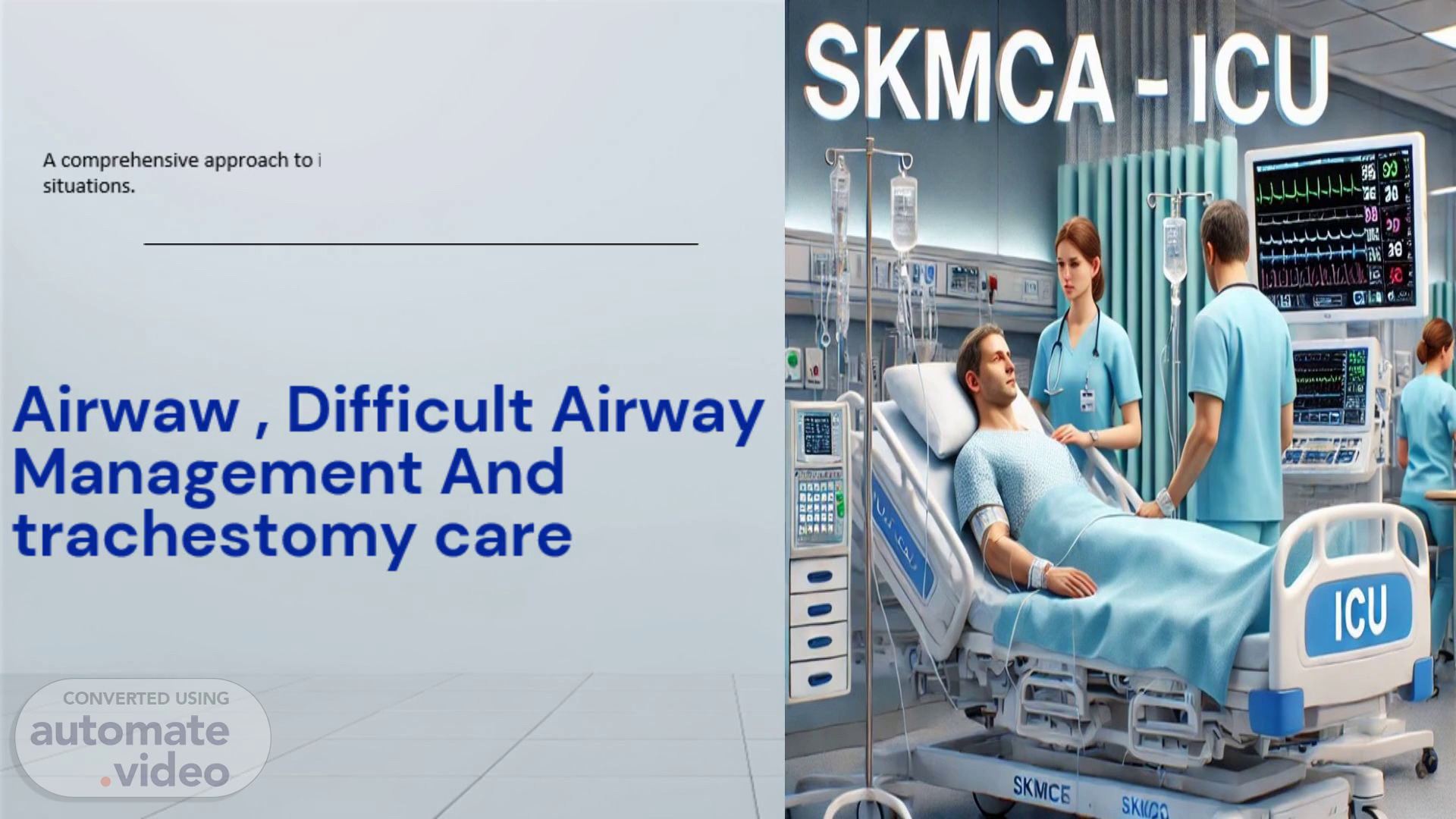
Airwaw , Difficult Airway Management And trachestomy care
Scene 1 (0s)
Airwaw , Difficult Airway Management And trachestomy care.
Scene 2 (9s)
Introduction. This presentation covers essential aspects of difficult airway management, including assessment, techniques, and post-management care..
Scene 3 (19s)
Assessment. 01. ! 1088. Air way Assessment And Prevention In adult Patients And management.
Scene 4 (28s)
Understanding the anatomy of the upper airway is crucial for effective management. This includes knowledge of key structures such as the epiglottis, vocal cords, and trachea, which play significant roles in airway patency..
Scene 5 (42s)
Identify risk factors. Recognizing risk factors is essential for anticipating difficulties in airway management. Factors include obesity, history of difficult intubation, anatomical variations, and specific medical conditions affecting airway access..
Scene 6 (55s)
Various tools and techniques assist in evaluating the airway. These include the visualization and tools like videolaryngoscopes that enhance visualization during intubation..
Scene 7 (1m 6s)
AIRWAY TYPE. 02. [image]. AIR WAY. Air way. Simple Airway Advance Airway Nasal cannula Endotracheal tube face mask LMA Non-breath mask TRACHESTOMY Venture mask HFNC Cricothyrotomy NIV Cpap.
Scene 8 (1m 19s)
OXYGEN THERAPY There are many different oxygen delivery devices which offer different flow and concentration (F102), and should be titrated as ordered. NASAL CANNULA SIMPLE FACE MASK VENTURA MASK NON REBREATHER HIGH-FLOW NASAL CANNULA 7 FLOW (L/min) 2-6 6-10 3-10 10-15 30-60 F102 25-40 35-50 24-60 80-90 100 This is not a complete list but these are the most frequently used. Oxygen can also be utilized with CPAP or BIPAP machines to improve not only oxygenation but also ventilation. HealthandWiIIness.org.
Scene 9 (1m 47s)
Endotracheal intubation is a critical skill in airway management. It involves the insertion of a tube through the vocal cords into the trachea to secure the airway, requiring precise technique and appropriate equipment. Watch this video down to see how is the intubation:.
Scene 10 (2m 5s)
laryngeal mask airways (LMA) are supraglottic airway devices. They may be used as a temporary method to maintain an open airway during the administration of anesthesia or as an immediate life-saving measure in a patient with a difficult or failed airway. Laryngeal mask airways were introduced into clinical practice in the 1980s, where they were initially used predominantly in the operating room. Since then, their use has become more widespread in the intensive care unit, emergency department, and field settings. This activity describes the indications, contraindications, and techniques involved in placing a laryngeal mask airway and highlights the role of the interprofessional team in the management of patients with difficult airways Watch this video down to see how is the insertion of the LMA :.
Scene 11 (2m 42s)
A tracheostomy is a surgical opening into the trachea below the larynx through which an indwelling tube is placed to overcome upper airway obstruction, facilitate mechanical ventilator support and/or the removal of tracheo-bronchial secretions.
Scene 12 (3m 34s)
Cricothyrotomy is an emergency surgical procedure used to secure the airway during situations where intubation is not possible. It involves making an incision through the skin over the cricothyroid membrane and inserting a tube directly into the airway. This technique is crucial for immediate airway access in cases of severe airway obstruction..
Scene 13 (4m 28s)
Management Strategies. 03.
Scene 14 (4m 34s)
Prevention and preparedness. Effective management of difficult airways begins with prevention and preparedness. This includes pre-anesthesia assessments to identify potential issues and having a clear plan and necessary equipment available for airway management challenges..
Scene 15 (4m 47s)
Utilizing a structured algorithm for decision-making helps streamline the response to airway difficulties. The algorithm includes steps for initial airway assessment, alternative procedures if intubation fails, and a review of potential surgical interventions..
Scene 16 (5m 0s)
Difficult airway management poses numerous challenges, including anatomical variations, patient cooperation, and the urgency of the situation. Understanding these challenges and preparing for them enhances the effectiveness of airway interventions..
Scene 17 (5m 13s)
Post-Management Care. 04.
Scene 18 (5m 20s)
Post-management care includes continuous monitoring of the airway, vital signs, and overall patient status. Prompt assessment can identify complications early and guide necessary interventions..
Scene 19 (5m 32s)
Complications to watch for. In the post-management phase, various complications may arise, such as airway obstruction, trauma to the airway structures, and inadvertent tube displacement. Being vigilant for these issues ensures timely and appropriate care..
Scene 20 (5m 46s)
Establishing clear follow-up protocols post-airway management is essential for ensuring patient safety and recovery. This includes scheduled evaluations, assessing airway integrity, and planning for potential interventions if complications arise..
Scene 21 (5m 59s)
Effective management of difficult airways requires a comprehensive understanding of assessment, techniques, and post-management care. By utilizing structured approaches and preparing for challenges, healthcare providers can enhance patient safety and outcomes in critical situations..
Scene 22 (6m 13s)
Thank you!. Do you have any questions?. +91 620 421 838.